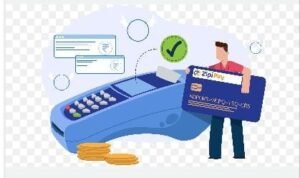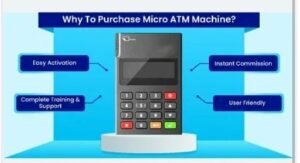how does micro atm work
In India’s ongoing journey towards financial inclusion, Micro ATMs have emerged as a transformative solution to bridge the gap between unbanked populations and formal banking services. Micro ATMs area small, portables device’s operated by banking agent’s known as Business Correspondent’s (BCs) that’s enable basic blanking service’s at there grass-roots level. They were created to bring banking closer to rural and remote areas.
What is a Micro ATM?
A handheld, card-swiping Micro ATM connects to a bank’s core system via secure mobile or internet networks. It serves as a miniature banking terminal, enabling customers to carry out essential banking transactions without going to a full-sized ATM or traditional bank branch.
These devices are used in rural villages, semi-urban areas, and underbanked neighborhoods where traditional ATMs are either unavailable or impractical. They are operated by authorized agents appointed by banks or financial institutions.
Key Components of a Micro ATM
- Micro ATM or POS (Point-of-Sale)
- Machine Scanner for Fingerprints (Biometric Authentication)
- Reader for credit and debit cards
Connectivity via GPRS and mobile SIM Setup with or without a battery

Software that works together for real-time transactions
The Aadhaar Enabled Payment System (AePS), developed by NPCI (National Payments Corporation of India), allows customers to access their bank accounts using Aadhaar numbers and biometric verification. Most micro ATMs are Aadhaar-enabled.how does micro atm work
How Micro ATM Works
For those who may not be tech-savvy, the procedure for micro ATM transactions is straightforward and user-friendly:
Function:
A Micro ATM is a small, handheld machine that lets you do important banking transactions like withdrawing cash, checking your balance, and moving money. It serves as a miniature bank terminal, which is especially useful in rural or remote areas where there are no full-sized banks.
Operation:
A banking agent controls the device, which is mobile-connected to the bank’s network. Customers use Aadhaar and their fingerprint, or a debit card and a PIN, to verify themselves. After the details of the transaction are entered by the agent and verified, the amount is immediately credited or debited. A receipt is provided immediately.
Benefits:
By providing secure, quick, and convenient banking access, micro ATMs encourage financial inclusion, particularly among underserved populations in rural India.
Interoperability: Micro ATMs area compatibles with a variety of bank’s, allowing customer’s to accessible their account’s Frome any Bank.
Security: Aadhaar-based biometric authentication or PIN verification safeguards transactions, ensuring safe and dependable access to financial services even in remote areas and reducing fraud and abuse.
Agent Authentication
Using a secure ID and password provided by the bank, the Business Correspondent (BC) logs into the Micro ATM system.how does micro atm work
Customer Authentication
The customer supplies either their bank-issued debit card or their Aadhaar number. Aadhaar-based biometric verification, in which the user authenticates through a fingerprint scan, is used in the majority of transactions.
Select Transaction Type
The customer selects one of the offered services:
- Balanced Research
- Cash Transfer
- Deposit of Cash (if enabled)
- Short Statement
- Transfer of Funds (limited use)
The BC starts the process after selecting the transaction. The required amount is entered for deposits and withdrawals.
Micro ATM Cash Withdrawal Process
1. Approach a Banking Agent:The customer goes to a banking agent or Business Correspondent (BC) with a Micro ATM.
2. Select a Method of Authentication:Based on Aadhaar: The customer provides their Aadhaar number and uses biometric (fingerprint) verification.
Card-Based: Customer inserts their debit card and enters the Digit PIN.
3. Choose a Type of Transaction: On the Micro ATM interface, the agent selects “Cash Withdrawal.”
4. Enter Withdrawal Amount:
The agent enters the requested amount into the device.how does micro atm work
5.Real-Time Bank Verification:
The device connects to the customer’s bank server via GPRS or a mobile network. The system verifies credentials and checks for balance.
6. Transaction Approval:
There transactions is immediately approved once verifications is successfully.
7. Disbursement of Cash: The customer receives the exact amount of cash that the agent requested.

8.Receive Payment: A receipt for a transaction can be printed or sent as an SMS message.
Even in rural or low-infrastructure areas, this procedure ensures secure, paperless, and quick withdrawals.how does micro atm work
- Biometric or PIN Verification
- Aadhaar users confirm via fingerprint
- Card users verify via PIN
- Real-Time Processing
The bank’s server is connected to the Micro ATM via the internet or mobile network. After the request is verified immediately, the transaction is completed.
Cash Disbursement or Collection
If it’s a withdrawal, the agent gives cash from their own float (cash-in-hand provided by the bank). The customer gives the agent cash for deposits.
Receipt Generation (Optional)
The customer receives an SMS that confirms the transaction. Mini receipts can also be printed on some devices.
Features of Micro ATM
1. Portability: Compact, lightweight, and easy to carry for on-site banking.
2. Interoperability: Aadhaar or debit card transactions from multiple banks are supported. how does micro atm work
3. Biometric Authentication: Enables secure access through Aadhaar-linked fingerprint verification.
4. Card-Based Access: Debit cards with a PIN are accepted for balance checks and withdrawals.
5. Real-Time Connectivity: Uses GPRS or mobile data to connect to bank servers.
6. Transaction Types: Supports cash withdrawals, balance inquiry, mini Statement, and funds Transfer.
7. Instant Receipt: Prints or sends an SMS to confirm a transaction.
8. Power Efficient: Operates on low power, often battery-enabled for use in remote areas.
9. Tool for Financial Inclusion: Provides banking services to underserved and rural populations.
10.supports DBT:enables direct benefit transfers from government programs to beneficiaries, supports DBT.
Benefits of Micro ATMs
Financial Inclusion:Enables banking in remote and unbanked regions.
Low Infrastructure Cost: No full bank branches or ATMs are required.
User-Friendly:Suitable for people with low digital literacy.
Secure:Secure transactions are guaranteed by Aadhaar biometric verification.
Time-Saving:prevents people living in rural areas from having to travel far to get to banks.
Flexible Operation:works even with battery power and mobile network power.
Challenges and Limitations
Connectivity Issues:Poor mobile network coverage can delay transactions.
Limited Cash Float:During periods of high demand, agents may run out of cash.
Awareness and Trust:Users in rural areas might be wary of fraud or doubt new technology.
Limited Services:Not suitable for complex banking needs like opening accounts or loans (though eKYC is gradually improving this).
Micro ATM in Government Schemes

The delivery of government subsidies, pensions, and DBT (Direct Benefit Transfers) under programs such as:
- Pradhan Mantri Jan Dhan Yojana (PMJDY)
- Program for Social Assistance (NSAP)
At a Micro ATM, which types of card’s can be used?
1. Credit Cards: Rupay, Visa, and MasterCard—the majority of debit cards issued by banks—are accepted for transactions.
2. Cards for RuPay: RuPay cards are made to be used at home and seamlessly function on Micro ATMs.
3. Cards Prepaid: Only a few transactions can be made with certain prepaid cards that have been approved by the bank.
4. Cards Linked to Aadhaar: Access to subsidies and authentication are supported by cards linked to Aadhaar accounts.
5. Cards for Government Schemes: Beneficiary cards issued under financial inclusion programs may also be used.
Because they accept a variety of card types, micro ATMs make banking services available to a large population.
MGNREGA wage payments
Micro ATMs ensure that benefits reach the last-mile citizen directly by delivering banking to their doorsteps through BC agents.
Conclusion
In India, rural banking is being totally transformed by micro ATMs. They offer a cost-effective, secure, and scalable way to extend essential banking services to people who were once excluded from the formal financial system. Micro ATMs have the potential to play an even larger role in India’s journey toward total financial inclusion with ongoing improvements to digital infrastructure and policy support.
